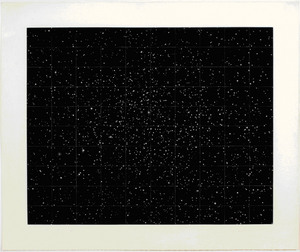This is an archive of the ArtCat Zine, 2007-2009. Please visit our new project, IDIOM.
to: Night at Hunter
to: Night -- Contemporary Representations of the Night
Curated by Joachim Pissarro, Mara Hoberman and Julia Moreno
Bertha and Karl Leubsdorf Art Gallery - South West Corner of E 68 St and Lexington, New York NY
25 September - 6 December 2008
Times Sq Gallery - 450 W. 41 St, New York NY
25 September - 15 November 2008
In response to Van Gogh's Colors of the Night exhibition at MoMA, a show at Hunter College wonders how the legend would depict the starry night if he were alive today. to: Night - Contemporary Representations of the Night explores night with the digital techniques and high technological mediums of our moment. Most of the works are not paintings but share Van Gogh's wild comfort level with risks that only the future could admire.
The starry sky twinkles everywhere in the show. Stars shine beside dark surroundings with an audacity that's irresistibly admirable. The light's scarcity makes their illumination precious. There is an ancient stillness at night that lends itself to gazing up and enjoying the stars that many of these works capture.
The challenge of depicting the night sky is that it becomes monotonous to staple a dark background with evenly spaced silvery dots. That star field screensaver got to be so boring. Van Gogh was on the right track when he embraced the Milky Way. He weaves the curvilinear flourishes of art nouveau into a glowing lace at the center of his famous picture. Yellow stars orbit around that silver nebula like planets and move the eye around the picture. Only Jen DeNike and Robert Longo mined the full potential of the Milky Way and their sky's swirl with a formal density. Perhaps the light polluted city sky and screensavers deeply shapes how many artists see the night.
Vija Clemins reveals another strategy to keep the evening sky engaging. At first, it appears guilty of the screensaver's boring uniformity. But as your eyes adjust to her visual language, one starts to detect the subtle different intensities with which her stars shine and twinkle. In such an overstated era like our own, such understatement is refreshing.
Dark rooms with illuminated installations recreate that nocturnal scarcity of light that makes it so precious. The blackest space requires some retinal patience. The works are so dim and the room so dark that only dilated eyes can perceive the starry landscapes. Lauren Orchowski presents more three dimensional dioramas of nocturnal landscapes. Her works focus on that moment of twilight when the last remnants of the sunset still linger in the sky. The spindly trees and crumbly architecture hit the Halloween appeal without going overboard. Glowing trees with autumn's bright colors stand in Doina Kraal's dark room.
Light boxes and light tubes glow like nightlights in other dark rooms. Spencer Finch's works illuminate pure geometric patterns but the colors really leap out of darkness. Barney Kulok depicts actual photographed scenes. In one clever shot, his shutter grabs an image of a sports field in a park that is starkly illuminated by white lights. Kulok's shining light box breathes new life into his patterns and scenery.
The theme of the lonely city at night was pervasive. Some artists focused on scenery and areas of the city that humans abandon during nightfall. Juliane Eirich photographs chairs that remain on the beach's sand after everyone's gone home for the night. A long city block with mostly closed stores, a vacant sidewalk, and an empty street is the subject of one of Stan Douglas's photographs. Nights of social isolation hit hard. Social blunders aside, this experience of walking down the street alone is the consequence of car culture and the kinds of cities Americans build to accommodate their vehicles. Single zoning creates vast areas that evening abandons, shelters spaced far apart, and streets that get little traffic at night.
But many cities in the world were built before the car and experience night dramatically differently. Rome built or inspired the compact cores of most European cities. Broadly speaking, cities that grew during the Middle Ages and Renaissance expanded according this Roman pattern of mixed-use buildings and narrow streets. It's nearly impossible to feel alone at night in London as the streets crawl with drunkards, the pubs swell with laughing chatter, and most of the city subsequently endures a long walk home after the metro closes. It was unusual that this more social experience of night imbedded within the old Roman-style of urban living was so conspicuously absent.
Most of the works that engage with evening sexuality were jaded rather than jubilant. Gregory Crewdson shows a maternal figure discovering an awkward girl standing outdoors in her undergarments. There was nothing erotic or tender about Kohei Yoshiyuki's images of people spying on others performing sex acts in public places. Marc Swanson and Neil Gust's video indicted the nightclub as hollow and damaging rather than entertaining or cathartic. A deeply Victorian sexual hunger tortures those whose desire lingers in this show; feelings of joy or perhaps the possibility of getting lucky are absent.
Episodes of isolation or twisted sexual encounters may be just a thin slice of nocturnal experience. But during these darkest moments of the night, there is a gothic intensity that day rarely achieves. Many of these works tap into the horrors that only night can deliver. Likewise, others work revel and bask in the starry wonder and glowing light that we never see under bright sunshine. Both the beauty and terror of the night is on full view.
ZINE
HOME
TIPS / COMMENTS
CATEGORIES
CONTRIBUTORS
- Greg Afinogenov
- B. Blagojevic
- Adda Birnir
- Susannah Edelbaum
- Julie Fishkin
- Paddy Johnson
- Jessica Loudis
- Christopher Reiger
- Andrew Robinson
- Peter J. Russo
- Blythe Sheldon
- S.C.Squibb
- Hrag Vartanian


